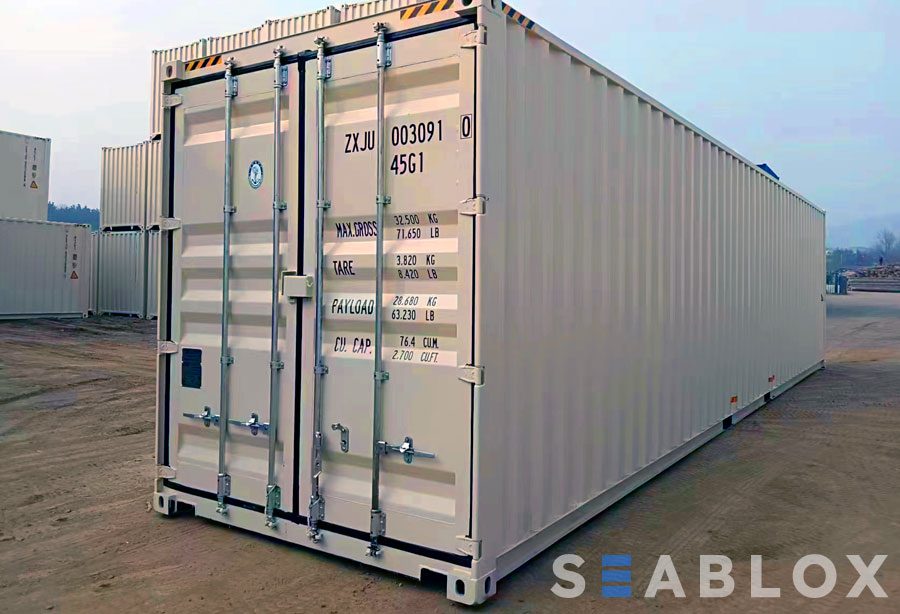Shipping containers are an essential tool for many industries, providing a convenient and secure method of transporting goods across the globe. Among the most commonly used containers is the 40′ shipping container. This versatile container has become an industry standard for transporting large quantities of goods, and its dimensions and specifications are carefully designed to meet the demands of modern logistics.
| 40′ Standard Height | Dimensions |
|---|---|
| Internal Length | 12.03m / 39.5ft |
| Internal Width | 2.3m / 7.9ft |
| Internal Height | 2.3m / 7.9ft |
| External Length | 12.19m / 40ft |
| External Width | 2.44m / 8ft |
| External Height | 2.59m / 8.5ft |
| Tare Weight | 3,750kg / 8,268.8 lbs |
| Payload Capacity | 27,600kg / 61,200 lbs |
| Cubic Capacity | 67.7 cu m / 2,389 cu ft |
| 40′ High Cube | Dimensions |
|---|---|
| Internal Length | 12.03m / 39.5ft |
| Internal Width | 2.3m / 7.9ft |
| Internal Height | 2.70m / 8.10ft |
| External Length | 12.19m / 40ft |
| External Width | 2.44m / 8ft |
| External Height | 2.90m / 9.5ft |
| Tare Weight | 3,900kg / 8,598 lbs |
| Payload Capacity | 28,600kg / 63,052 lbs |
| Cubic Capacity | 76.3m3 / 2,694.5 cu ft |
Materials used in 40′ Shipping Container Construction
Most 40′ shipping containers are made from corten steel, a type of high-strength, low-alloy steel that is highly resistant to corrosion and weathering. The walls and roof of the container are typically constructed from corrugated steel panels, while the floor is made from marine-grade plywood or steel. The doors at one end of the container are equipped with locking mechanisms to ensure secure storage and transportation of goods.
The plywood flooring in a shipping container is designed to withstand heavy loads and repeated use. In standard 40′ shipping containers, the flooring is typically made from marine-grade plywood, which is resistant to moisture and decay. The thickness of the plywood varies depending on the manufacturer and intended use, but is typically around 28mm. In high cube containers, the flooring is often made from steel instead of plywood, which provides additional strength and durability. The flooring is typically supported by cross members, which are welded to the underside of the container to distribute the weight of the cargo evenly.
How many pallets can fit into a 40-foot container?
One of the main advantages of a 40-foot container is its capacity to hold more cargo compared to a 20-foot container. When it comes to pallets, a 40-foot container can hold more than double the amount that can fit in a 20-foot container.
The number of pallets that can fit into a 40-foot container depends on several factors such as the size of the pallets, the dimensions of the container, and the nature of the cargo being transported. In general, a standard 40-foot container can hold up to 20 standard pallets in a single tier. However, this number can vary based on the dimensions of the pallets and the cargo being transported.
If the pallets are standard size, measuring 1,200 mm x 1,000 mm, then up to 20 pallets can be loaded into a 40-foot container in a single tier. However, if smaller pallets are being used, then it is possible to load more pallets into the container. On the other hand, if larger pallets are being used, then fewer pallets may fit in the container.
It is important to note that while a 40-foot container can hold more pallets compared to a 20-foot container, it is still important to consider the weight and dimensions of the cargo being transported to avoid exceeding the maximum payload capacity and weight restrictions of the container. Proper loading and securing of the pallets are also crucial to ensure the safety of the cargo during transport.
40′ shipping container is a critical tool for many businesses involved in global logistics. Its dimensions and specifications are carefully designed to provide ample space for transporting a wide range of goods, while its construction materials ensure that it can withstand the rigors of international transportation. Whether shipping large volumes of goods across oceans or providing on-site storage for construction materials, the 40′ shipping container is an invaluable asset for any business involved in logistics.

